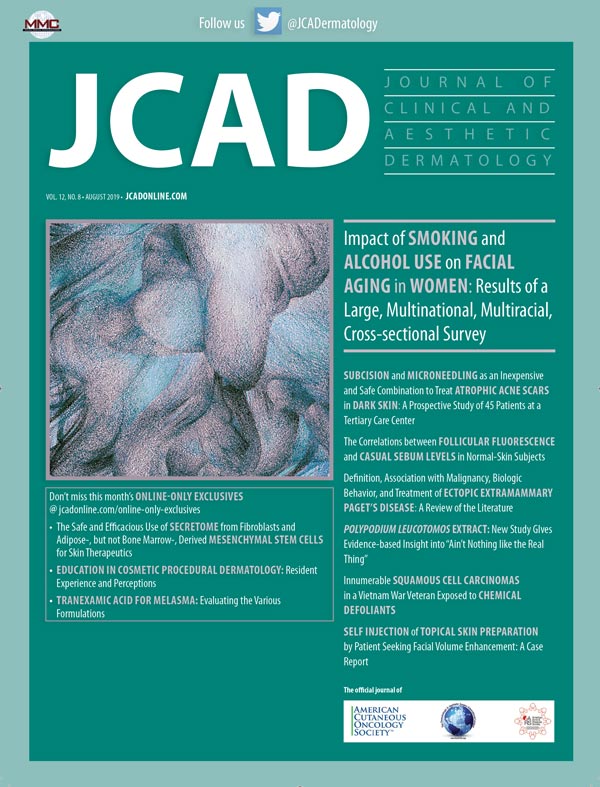 Dear Colleagues:
Dear Colleagues:
Welcome to the August 2019 issue of The Journal of Clinical and Aesthetic Dermatology (JCAD). We begin the issue with an article by Bhargava et al, the authors detail the results of their study evaluating subcision and microneedling as a treatment for atrophic acne scars in 45 patients with dark skin at a tertiary care center. The patients underwent four sessions, each four weeks apart, and were assessed three months after their final treatment. Overall, the authors reported an improvement of acne scars by at least one grade in 95.6 percent of the patients; according to self-reported patient assessments, 17.8 percent of the patients perceived a 75- to 100-percent improvement in their scars.
Next, Asawononda et al present the results from a study titled, “The Correlations between Follicular Fluorescence and Casual Sebum Levels in Subjects with Normal Skin,” in which the authors sought to evaluate the association between ultraviolet-induced red fluorescence (UVRF) and casual sebum levels in 30 subjects with normal skin. The authors note that this relationship has only been studied previously in subjects with acne-prone and/or oily skin. The authors observed positive correlations between UVRF, represented by porphyrin counts, and casual sebum levels in the cheeks, nose, and forehead areas of the participants.
Following this, in an original research article by Goodman et al titled, “Impact of Smoking and Alcohol Use on Facial Aging in Women: Results of a Large Multinational, Multiracial, Cross-sectional Survey,” the authors discuss their subanalysis of a cross-sectional, Internet-based survey of self-reported facial aging in women across the United States, Australia, Canada, and the United Kingdom in order to determine which clinical signs of skin- and volume-related facial aging are associated with tobacco and alcohol use in women. The authors’ analysis included 3,267 women and found that smoking was associated with an increased severity of forehead, crow’s feet, and glabellar lines, as well as under-eye puffiness, tear-trough hollowing, nasolabial folds, oral commissures, perioral lines, and reduced lip fullness, but not midface volume loss or visible blood vessels. Heavy alcohol use (more than 8 drinks/week) was associated with increased upper facial lines, under-eye puffiness, oral commissures, midface volume loss, and blood vessels.
Next, in a review titled, “Definition, Association with Malignancy, Biologic Behavior, and Treatment of Ectopic Extramammary Paget’s Disease (E-EMPD): A Review of the Literature,” Scarbrough et al discuss the classification, origin, and management of a rare form of adenocarcinoma that affects apocrine gland-bearing skin and whose etiology and pathophysiology are largely unknown. The authors conclude their article by recommending a focused malignancy screening following a diagnosis of E-EMPD and identify surgical excision as the most common first-line treatment for patients with E-EMPD.
Next, Desimone and Beatson discuss the case of an immunocompetent, 84-year-old, Caucasian man with at least 30 SCCs of the scalp, head, neck, and upper extremities, including a 4cm SCC on the vertex of the scalp infiltrating to the periosteum. The authors note the man was a retired Marine who fought in the Vietnam War and reported Agent Orange exposure. The invasive scalp lesion was treated by Mohs surgery and radiation, and the large SCC and field cancerization were successfully treated with a combination of topical and intralesional 5-fluorouracil with pulsed oral capecitabine, which resulted in a significant reduction in SCC disease burden.
Following this, Del Rosso provides a commentary regarding oral supplements containing Polypodium leucotomos extract (PLE), which has been shown to exhibit photoprotective properties which might provide adjunctive benefit when used with topically applied sunscreens. Del Rosso discussed results from a study of six different PLE formulations that compared their respective polyphenol and excipient contents and specific photoprotective properties.
Then, in a case report by Martin et al, the authors discuss the case of a 25-year-old man seeking increased prominence of the cheeks who self-injected a topical skin preparation containing hyaluronic acid into his malar soft tissues, leading to firm infraorbital swelling and hyperpigmentation in the same area. The man was ultimately treated with topical hydroquinone and hyaluronidase injections to the infraorbital areas.
Our online-only exclusives this month include a review from Maguire titled, “The Safe and Efficacious Use of Secretome From Fibroblasts and Adipose-derived (but not Bone Marrow-derived) Mesenchymal Stem Cells for Skin Therapeutics” the author discusses the safety and efficacy of adipose-derived stem cells for stem cell therapeutic development, medical procedures, and skin care products, compared to platelets and bone marrow stem cells. In addition, in a brief report from Nielson et al, the authors present results from a survey of 150 dermatology residents that assessed education in and expectations for cosmetic procedures during dermatology residency; the results suggest a lack of didactic and clinical training in cosmetic procedures during dermatology residency to meet resident expectations and future practice habits. Our third online-only exclusive is a review of various formulations of tranexamic acid for the treatment of melasma, including topical, intradermal, and oral. Our online-only exclusives can be accessed by visiting jcadonline.com/online-only-exclusives/ or via the e-Edition by visiting jcad.mydigitalpublication.com.
We hope you enjoy this issue of JCAD. As always, we welcome your feedback and submissions.
With regards,
James Q. Del Rosso, DO, FAOCD—Editor-in-Chief, Clinical Dermatology
Wm. Philip Werschler, MD, FAAD, FAACS—Editor-in-Chief, Aesthetic Dermatology
Seemal R. Desai, MD, FAAD— Associate Editor

